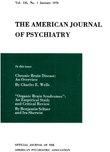THE FACADE OF CHRONOLOGICAL AGE : AN INTERPRETATIVE SUMMARY
Abstract
Old age is a period of rapid, profound and multiple changes of varying intensities, physiological and social, which influence subjective experience, behavior and adaptation. Characteristics possessed prior to old age modify the extent and the nature of these influences but do not fully account for the changes themselves. Clarification of the nature of these changes and their age-specificity is exceedingly difficult since chronological aging is imbedded in a matrix of many other factors ranging from social to physiological.
In general this sample, as might have been expected from its selection for medical health and social competence, was quite different from other samples of aged reported previously. The belief, for example, that cerebral blood flow and oxygen consumption necessarily decrease as the consequence of chronological aging per se was not confirmed: rather it was found that when such changes did occur they were the probable result of arteriosclerosis. Although some EEG changes occurred, particularly a showing in peak frequency, they were minimal and again became marked largely in the presence of anteriosclerotic disease. Cognitive performance in this sample compared favorably with the young but the psychologists found evidence of some slowing in speed processes as a consequence of aging. Moreover, psychometric tests appeared unusually sensitive to the presence of minimal disease states including arteriosclerosis. Whether alteration in speed is an intrinsic process associated with aging and whether it is a centrally-occurring process may require further clarification. Environmental deficits, health status, arterial blood pressure, depression (and indirectly audition) were major factors that did influence both mean reaction time and a general speed factor which was extracted by means of a principal component analysis from the psychometric data.
Social, personality, and health variables would therefore appear to be of considerable importance towards explaining the manifestations of aging. Indeed, it was very striking to us that in a population purposively biased in its selection for medical health and community-residence the powerful influences of these factors would still be revealed.
It is a fundamental problem in geriatric medicine, including psychiatry, to determine how to extract aging from other factors producing overt manifestations of disturbance. It is of particular interest to the psychiatrist that disease, particularly arteriosclerosis, sensory deficits and social deprivation, has far-reaching effects; these findings are important both to evaluation and to the conduct of any treatment and care program(16). If arteriosclerosis should become preventable or reversible, for example, the entire façade of aging may change surprisingly.
Our broad conclusion may be stated as follows: As a consequence of a careful multidisciplinary pilot study, we have found evidence to suggest that many manifestations heretofore associated with aging per se reflect instead medical illness, personality variables, and social-cultural effects. It is hoped that future research may further disentangle the contributions of disease, social losses, pre-existent personality, so that we may know more clearly what changes should be regarded as age-specific. Indeed, various types of investigations, complementing one another, would be useful. Intensive studies, involving frequent contact over considerable periods of time, based upon the growing personal relationship between the investigator and the older person, would contribute to our understanding of the subjective experience of aging and approaching death(16, 17). Longitudinal studies, of course, would enhance our opportunities of classifying changes as to whether they are age-specific, diseaselinked etc. Our own follow-up, after 5 years, is nearly complete and added new dimensions, notably data pertinent to mortality and survival(2). If we can get behind the façade of chronological aging we open up the possibility of modification through both prevention and treatment. In our lifetime (if at all) it is not likely that the inexorable processes of aging will be amenable to human intervention but it cannot be too greatly emphasized that it is necessary to be able to recognize those factors which are open to change.
Access content
To read the fulltext, please use one of the options below to sign in or purchase access.- Personal login
- Institutional Login
- Sign in via OpenAthens
- Register for access
-
Please login/register if you wish to pair your device and check access availability.
Not a subscriber?
PsychiatryOnline subscription options offer access to the DSM-5 library, books, journals, CME, and patient resources. This all-in-one virtual library provides psychiatrists and mental health professionals with key resources for diagnosis, treatment, research, and professional development.
Need more help? PsychiatryOnline Customer Service may be reached by emailing [email protected] or by calling 800-368-5777 (in the U.S.) or 703-907-7322 (outside the U.S.).



